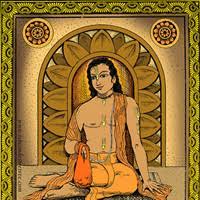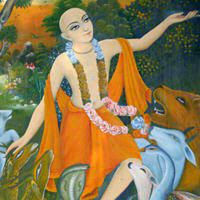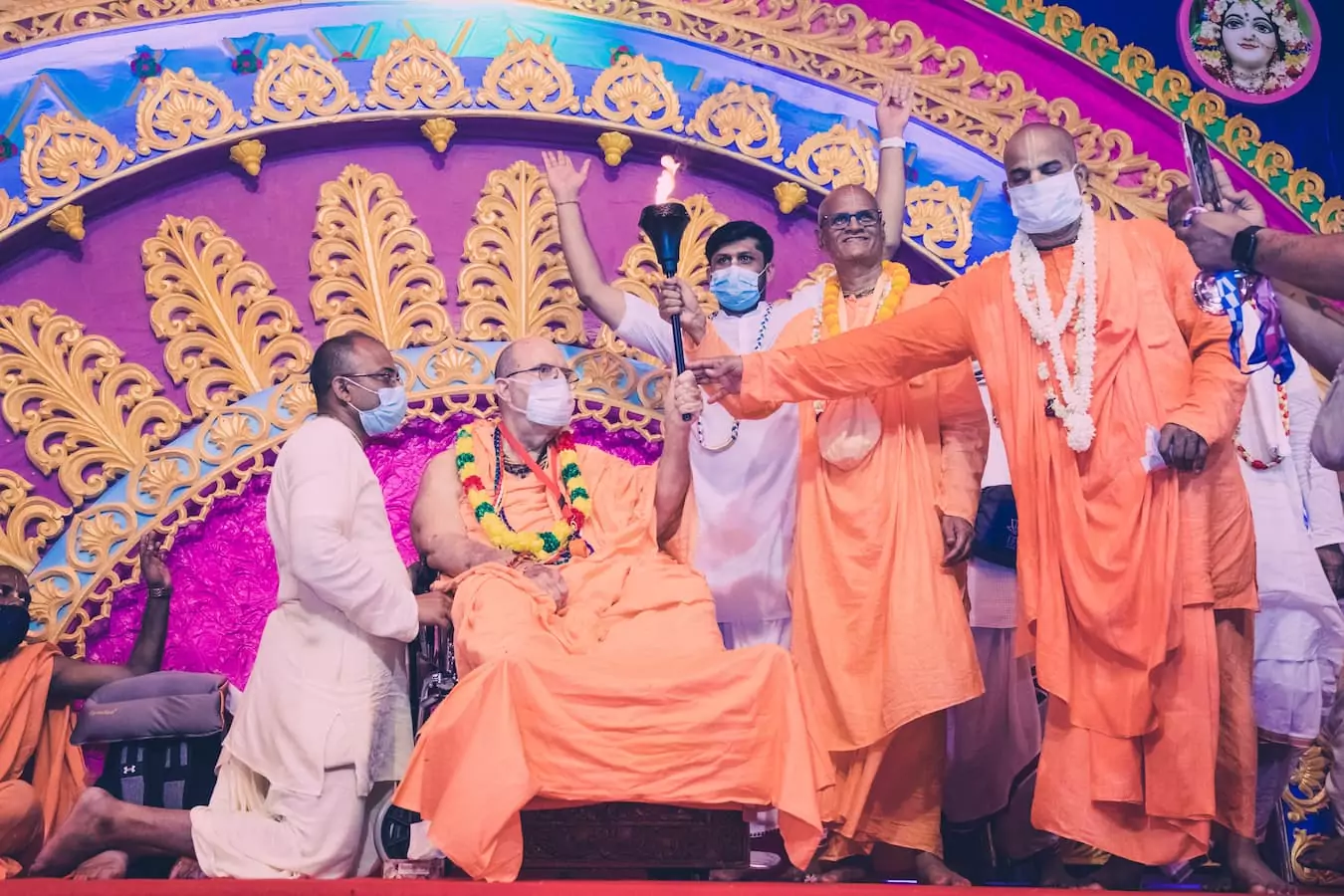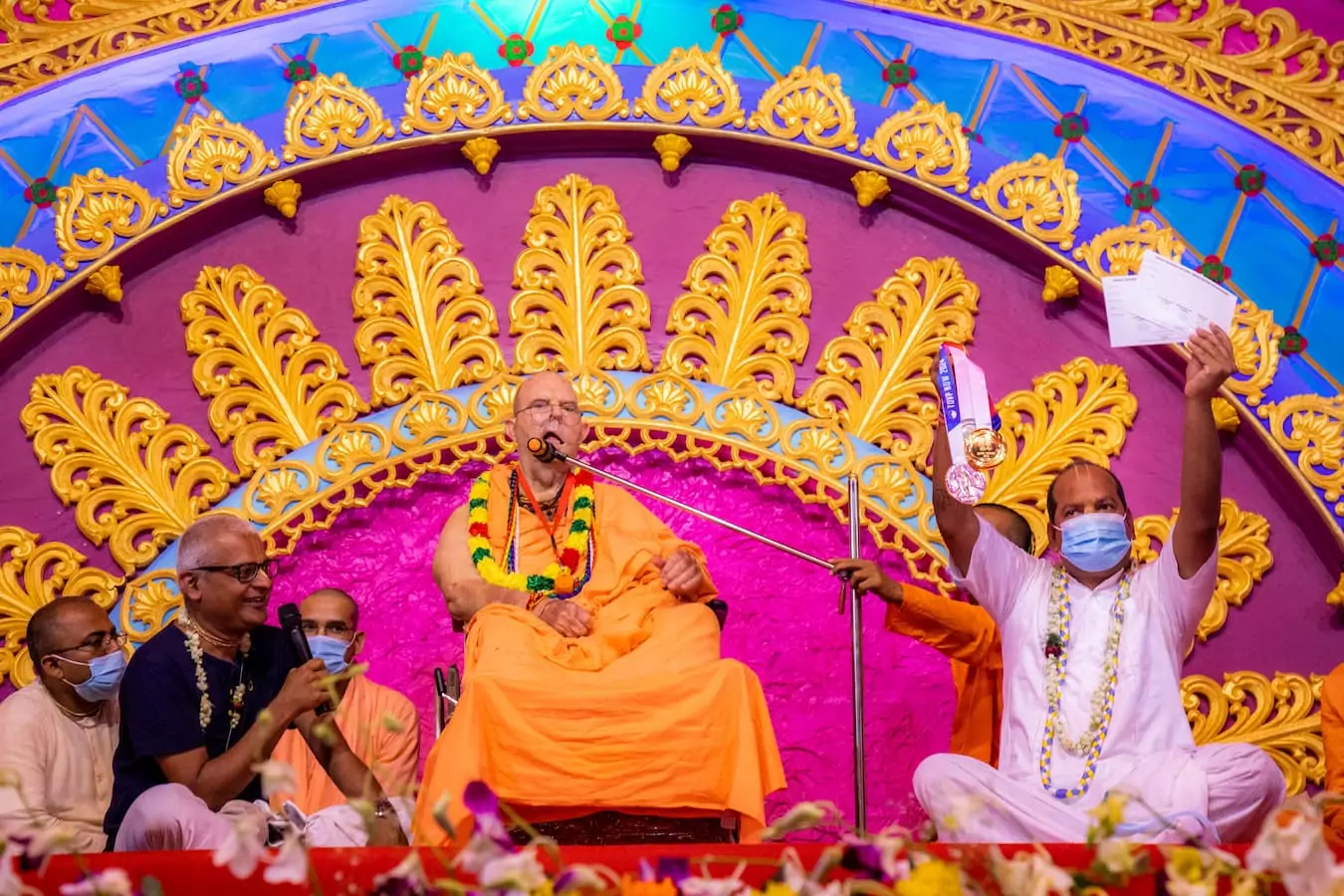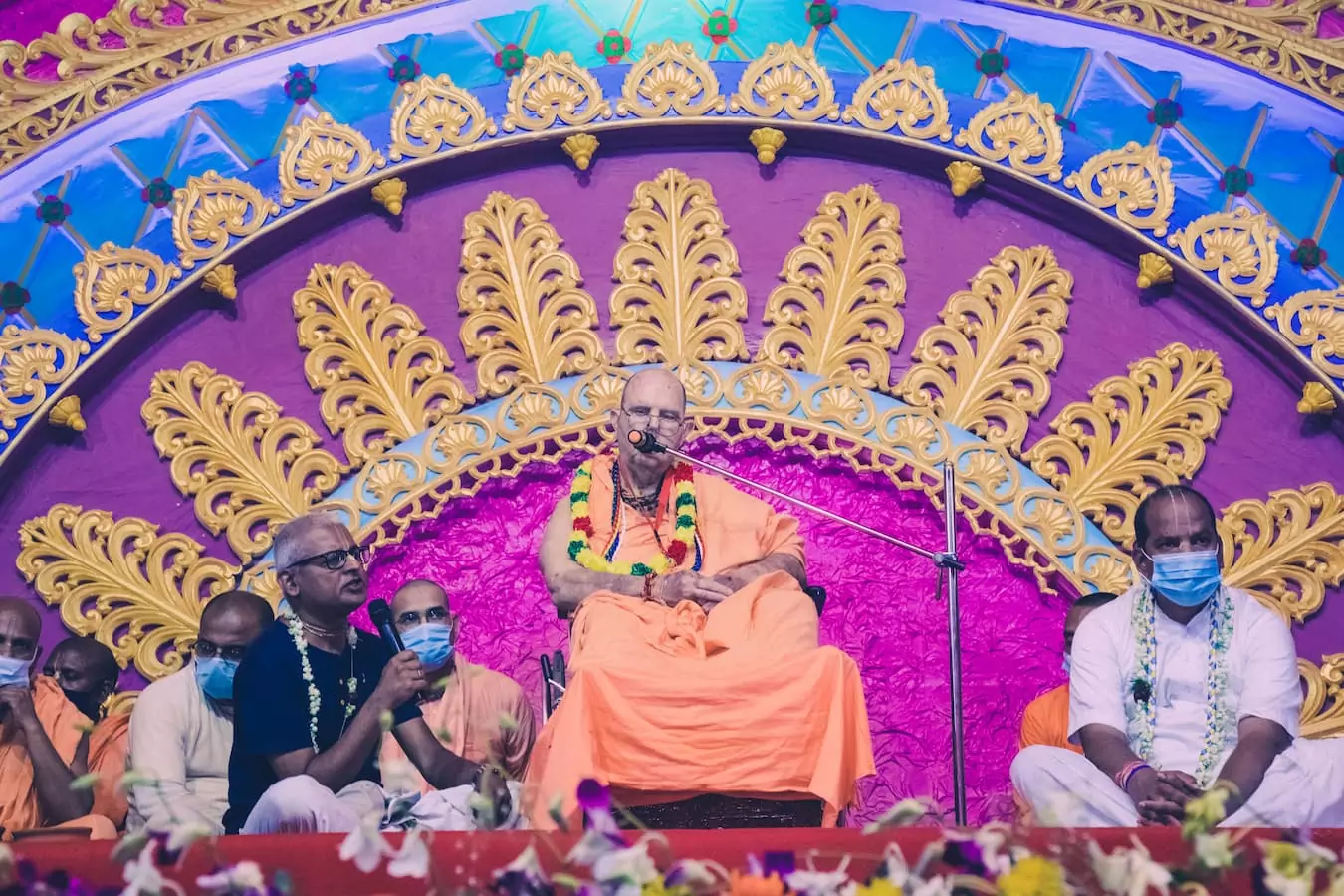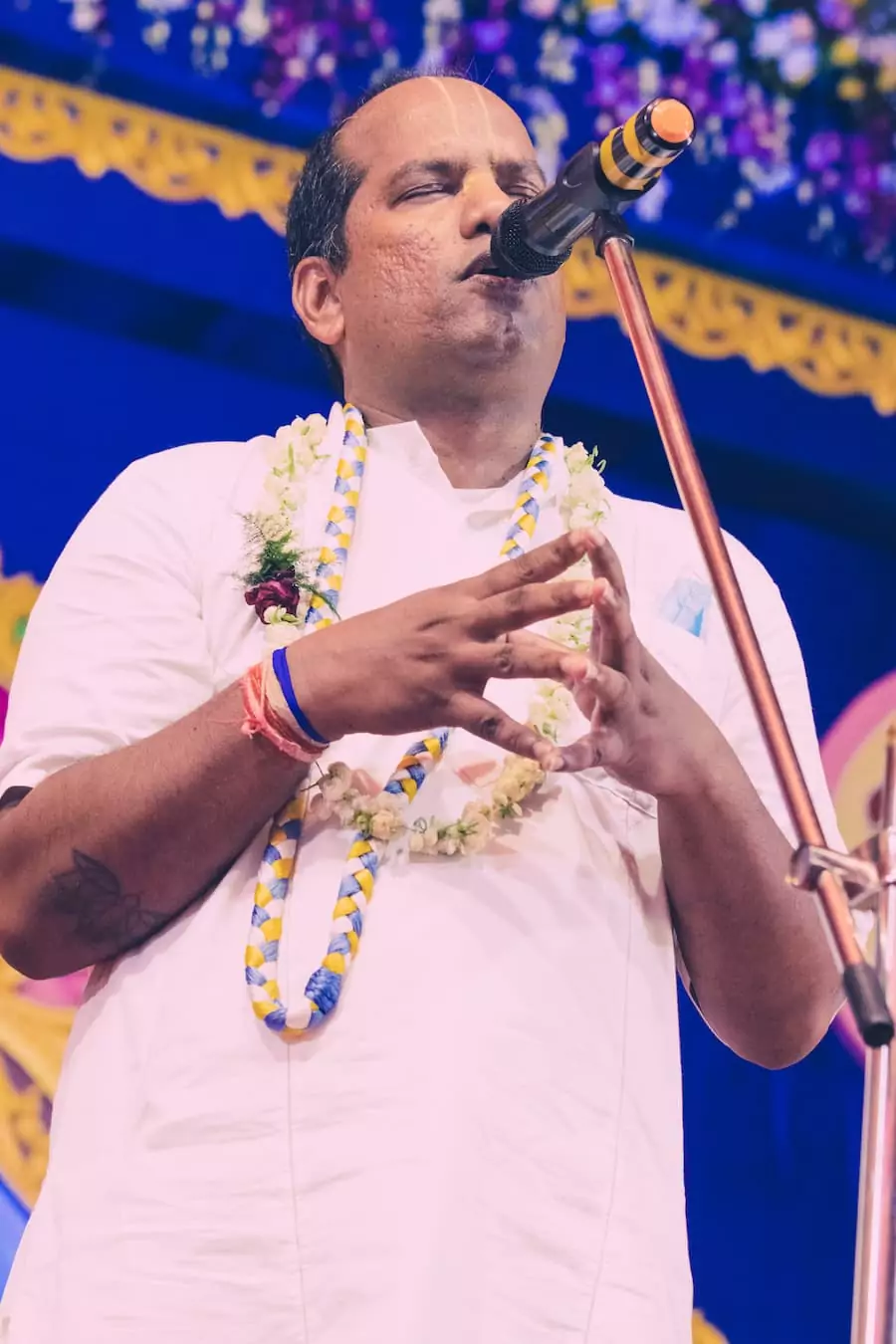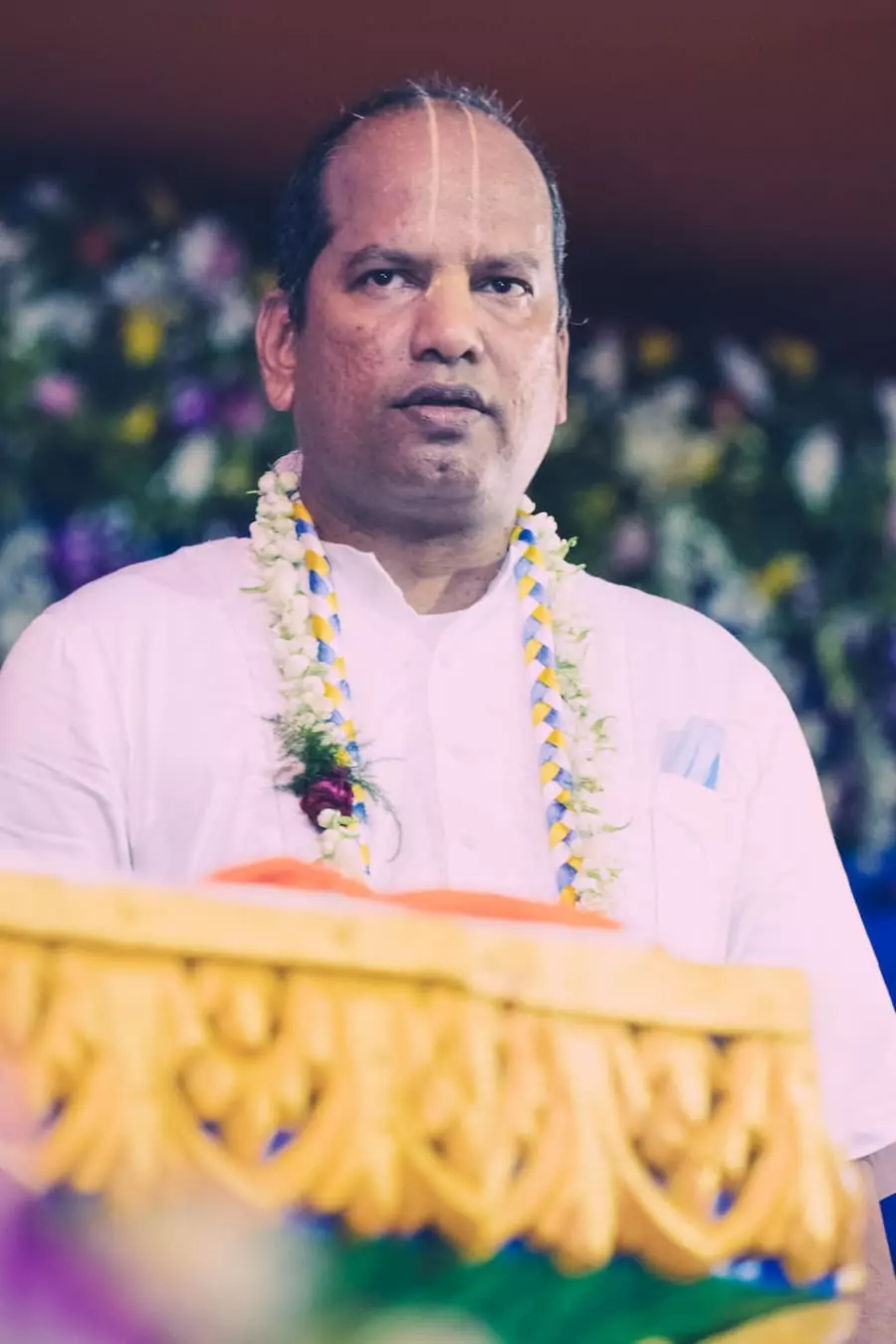 For Balarama Rasa-yatra, we shall read from Srila Prabhupada’s summary study of the Tenth Canto of Srimad-Bhagavatam, called Krsna, the Supreme Personality of Godhead—about Lord Balarama’s visit to Vrindavan after He and Krishna had been away from Vrindavan for many years.
For Balarama Rasa-yatra, we shall read from Srila Prabhupada’s summary study of the Tenth Canto of Srimad-Bhagavatam, called Krsna, the Supreme Personality of Godhead—about Lord Balarama’s visit to Vrindavan after He and Krishna had been away from Vrindavan for many years.
In our meditation on the deity of the Lord, we begin from His lotus feet and then gradually progress upward to His ankles, knees, thighs, waist, navel, chest, neck, and face. Srimad-Bhagavatam is also a form of the Lord, and so we begin its study with its lotus feet, which are the First and Second Cantos, and gradually progress upward until we get to the Tenth Canto, which is compared to the Lord’s smiling face. The topics in the Tenth Canto are very elevated and can actually be fully appreciated only by liberated souls—because Krishna’s pastimes with His pure devotees are enacted on the liberated platform—but on special occasions like Balarama Rasa-yatra we do explore such topics.
Some years ago I was in Vrindavan at this time, tending to a disciple, Arca-vigraha dasi, who was preparing to leave her body. Many senior devotees would come every day and read to her, discuss with her, and chant for her, and on this particular occasion I read the same pastime—about Lord Balarama’s visit to Vrindavan—from both the Tenth Canto and the Krsna book. The basic features of the pastime are the same in both texts, though there are little differences in terms of details and revelations of insights into the pastime. Today I shall read from the Krsna book, Krsna, the Supreme Personality of Godhead—Chapter Sixty-Five: “Lord Balarama Visits Vrndavana.”
TEXT
Lord Balarama became very anxious to see His father and mother in Vrndavana. Therefore, with great enthusiasm He started on a chariot for Vrndavana. The inhabitants of Vrndavana had been anxious to see Krsna and Balarama for a very long time. When Lord Balarama returned to Vrndavana, all the cowherd boys and the gopis had grown up; but still, on His arrival, they all embraced Him, and Balarama embraced them in reciprocation. After this He came before Maharaja Nanda and Yasoda and offered His respectful obeisances. In response, Mother Yasoda and Nanda Maharaja offered their blessings unto Him. They addressed Him as Jagadisvara, or the Lord of the universe who maintains everyone. The reason for this was that Krsna and Balarama maintain all living entities. And yet Nanda and Yasoda were put into such difficulties on account of Their absence. Feeling like this, they embraced Balarama and, seating Him on their laps, began their perpetual crying, wetting Balarama with their tears. Lord Balarama then offered His respectful obeisances to the elderly cowherd men and accepted the obeisances of the younger cowherd men. Thus, according to their different ages and relationships, Lord Balarama exchanged feelings of friendship with them. He shook hands with those who were His equals in age and friendship and with loud laughing embraced each one of them.
COMMENT by Giriraj Swami
There are many points in just this one paragraph. First, Lord Balarama offers obeisances to Nanda and Yasoda, who are playing the roles of His parents, and they in turn offer their blessings to Him—yet they refer to Him as Jagadisvara, the Lord of the universe. It appears contradictory that the Lord of the universe is offering obeisances to Nanda and Yasoda, and that they are offering blessings to Him. But in transcendental pastimes, there are two considerations: rasa and tattva. Rasa means the transcendental mellows exchanged between the Lord and the devotee in a loving relationship, and tattva means their existential positions. Although in terms of tattva, Balarama is the Personality of Godhead, visnu-tattva, and Nanda and Yasoda are devotees, in terms of rasa, in terms of their transcendental relationship, Nanda and Yasoda are in the position of parents to Balarama and Krishna (vatsalya-rasa).
Queen Kunti prayed to Krishna,
gopy adade tvayi krtagasi dama tavad
ya te dasasru-kalilanjana-sambhramaksam
vaktram niniya bhaya-bhavanaya sthitasya
sa mam vimohayati bhir api yad bibheti
“My dear Krsna, Yasoda took up a rope to bind You when You committed an offense, and Your perturbed eyes overflooded with tears, which washed the mascara from Your eyes. And You were afraid, though fear personified is afraid of You. This sight is bewildering to me.” (SB 1.8.31) The image of Mother Yasoda with rope in hand and Krishna trembling in fright with tears in His eyes—though Krishna is feared by fear personified—caused Kunti to become transcendentally bewildered.
In Krishna’s pastimes there are many such intricacies that can bewilder the intellect, and so we should mainly just hear and relish such topics; that is our first business. Once, when we were touring India with Srila Prabhupada, in Indore, a disciple asked him, “In some places we read that Lord Brahma is born from the lotus that sprouts from the navel of Lord Vishnu and then creates the different planets (as described in Srimad-Bhagavatam), but in other places we read that all the planets, the different planetary systems, are contained within the stem of the lotus that sprouts from Lord Vishnu’s navel. How do we reconcile these two versions?” Srila Prabhupada replied, “It is inconceivable. We cannot understand these topics with our tiny brains. Our only business is to love Krishna.” So we study scripture. Bhagavata-sravana, hearing Srimad-Bhagavatam, is one of the five most potent processes of devotional service, and we want to understand the science of Krishna consciousness—rasa and tattva and other elements—but we cannot really fully comprehend, or accommodate, these vast topics in our tiny brains, so ultimately we just surrender and hear and relish.
Another point is that Nanda and Yasoda address Balarama as Jagadisvara, as if to say, “We hear that You and Your younger brother are the Lords of the universe. Why, then, do You not protect Your elderly parents?” There is a slightly sarcastic, accusatory tone. On a very high level of Krishna consciousness, a devotee, out of pure love, can accuse or quarrel with the Lord. On the transcendental platform, we find the full range of emotions; everything exists there, but in its original, completely pure state (suddha-sattva), beyond the modes of material nature. Everything there is done out of love for Krishna. In the material world, anger is usually mixed with hatred. But in the spiritual world, the anger—transcendental anger—is mixed with love.
The Bhakti-rasamrta-sindhu and Caitanya-caritamrta and other scriptures inform us that beyond even the stage of prema there are further developments of transcendental love. The general progression is given in the Bhakti-rasamrta-sindhu (1.4.15–16):
adau sraddha tatah sadhu-
sango ’tha bhajana-kriya
tato ’nartha-nivrttih syat
tato nistha rucis tatah
athasaktis tato bhavas
tatah premabhyudancati
sadhakanam ayam premnah
pradurbhave bhavet kramah
“In the beginning there must be faith (sraddha). Then one becomes interested in associating with pure devotees (sadhu-sanga). Thereafter one is initiated by the spiritual master and executes the regulative principles under his orders (bhajana-kriya). Thus one is freed from all unwanted habits (anartha-nivrtti) and becomes firmly fixed in devotional service (nistha). Thereafter, one develops taste (ruci) and attachment (asakti). This is the way of sadhana-bhakti, the execution of devotional service according to the regulative principles. Gradually emotions (bhava) intensify, and finally there is an awakening of love (prema). This is the gradual development of love of Godhead for the devotee interested in Krsna consciousness.” (Brs 1.4.15–16, as Cc Madhya 23.14–15)
Generally we understand that devotees progress from sraddha, sadhu-sanga, bhajana-kriya, and anartha-nivrttih to nistha, ruci, and asakti and all the way to bhava and prema, but in the spiritual world there are developments beyond prema.
prema krame badi’ haya-sneha, mana, pranaya
raga, anuraga, bhava, mahabhava haya
“Love of Godhead (prema) increases and is manifest as affection (sneha), indignation (mana), love (pranaya), attachment (raga), further attachment (anuraga), ecstasy (bhava), and sublime ecstasy (maha-bhava).” (Cc Madhya 23.43) Beyond even prema is mana, a sort of transcendental anger, but that is possible only beyond the stage of simple prema, only for the residents of Vrindavan.
TEXT
After being received by the cowherd men and boys, the gopis, and King Nanda and Yasoda, Lord Balarama sat down, feeling satisfied, and they all surrounded Him. First Lord Balarama inquired from them about their welfare, and then, since they had not seen Him for such a long time, they began to ask Him different questions. The inhabitants of Vrndavana had sacrificed everything for Krsna, simply being captivated by the lotus eyes of the Lord. Because of their great desire to love Krsna, they never desired anything like elevation to the heavenly planets or merging into the effulgence of Brahman to become one with the Absolute Truth. They were not even interested in enjoying a life of opulence, but they were satisfied in living a simple life in the village as cowherds. They were always absorbed in thoughts of Krsna and did not desire any personal benefits, and they were all so much in love with Him that in His absence their voices faltered when they began to inquire from Balarama.
COMMENT
The different stages of advancement are hierarchical, and the qualities of a prior, or lower, stage are also included in the subsequent, higher stages. In the description of the residents of Vrindavan, Srila Prabhupada describes them in terms that apply to any pure devotee, on the platform of uttama-bhakti:
anyabhilasita-sunyam
jnana-karmady-anavrtam
anukulyena krsnanu-
silanam bhaktir uttama
“When first-class devotional service develops, one must be devoid of all material desires, knowledge obtained by monistic philosophy, and fruitive action. The devotee must constantly serve Krsna favorably, as Krsna desires.” (Brs 1.1.11, as Cc Madhya 19.167)
As stated in Srimad-Bhagavatam’s First Canto:
tulayama lavenapi
na svargam napunar-bhavam
bhagavat-sangi-sangasya
martyanam kim utasisah
“The value of a moment’s association with the devotee of the Lord cannot even be compared to the attainment of heavenly planets or liberation from matter, and what to speak of worldly benedictions in the form of material prosperity, which are for those who are meant for death.” (SB 1.18.13) By such association, beginning with even one moment, one can eventually attain pure devotional service and, like the residents of Vrindavan, have no interest in elevation to heavenly planets or merging into impersonal Brahman, what to speak of enjoying the opulences of this world. The Vraja-vasis were interested only in loving Krishna and serving Him. Their mood fits the basic definition of pure devotional service, which applies from the beginning stages of sraddha and sadhu-sanga up to the most advanced stages of anuraga and maha-bhava. So, too, with the different rasas: the elements of santa-rasa are included in dasya-rasa, the qualities of dasya are included in sakhya, the qualities of sakhya, including santa and dasya, are included in vatsalya, and the qualities of all four are included in madhurya.
It is not that when we become advanced we then desire material things. No. One disciple said to Srila Prabhupada, “When we are liberated, when we become paramahamsas, then we can do anything and it won’t affect us, because we will be on the transcendental platform. So then when we are paramahamsas we can also have sex.” And Srila Prabhupada replied that this was foolishness, and he told a story of a king’s servant. The king sometimes rode in a boat on an excursion, and the servant would walk alongside on a path that ran along the river and pull the boat from the land. The king was very pleased with the servant’s work and told him, “I am very pleased with you. I will give you whatever you like.” The servant replied, “I would like a velvet carpet to be placed along the path so that when I’m pulling the boat it will be soft under my feet.” Srila Prabhupada said that this was foolishness—the servant could have gotten anything and he wouldn’t have had to pull the boat anymore. He could have attained a boon far greater than doing the same thing but in a little different way. So, in response to the devotee’s comment—“Oh, if I become a paramahamsa I can have sex”—Srila Prabhupada said that when you are a paramahamsa you are in a position to relish on a much higher platform than that. Asking for sex after attaining the transcendental platform would be like asking for extra facility to pull the boat on the thorny path. The idea is param drstva nivartate, that on the highest level one experiences a higher taste and has no interest in elevation to heavenly planets or merging into impersonal brahmajyoti, what to speak of enjoying worldly pleasures that are meant for those who are bound for death.
Now the residents of Vrindavan are about to speak to Lord Balarama with faltering voices, feeling separation from Krishna.
TEXT
First Nanda Maharaja and Yasodamayi inquired, “My dear Balarama, are our friends like Vasudeva and others in the family doing well? Now You and Krsna are grown-up married men with children. In the happiness of family life, do You sometimes remember Your poor father and mother, Nanda Maharaja and Yasoda-devi? It is very good news that the most sinful King Kamsa has been killed by You and that our friends like Vasudeva and the others who had been harassed have now been relieved. It is also very good news that You and Krsna defeated Jarasandha and Kalayavana, who is now dead, and that You are now living in a fortified residence in Dvaraka.”
When the gopis arrived, Lord Balarama glanced over them with loving eyes. Being overjoyed, the gopis, who had so long been mortified on account of Krsna’s and Balarama’s absence, began to ask about the welfare of the two brothers. They specifically asked Balarama whether Krsna was enjoying His life surrounded by the enlightened women of Dvaraka Puri. “Does He sometimes remember His father Nanda and His mother Yasoda and the other friends with whom He so intimately behaved while in Vrndavana? Does Krsna have any plans to come here to see His mother, Yasoda, and does He remember us gopis, who are now pitiably bereft of His company? Krsna may have forgotten us in the midst of the cultured women of Dvaraka, but as far as we are concerned, we still remember Him by collecting flowers and sewing them into garlands. When He does not come, however, we simply pass our time by crying. If only He would come here and accept these garlands we have made. My dear Lord Balarama, descendant of Dasarha, You know that we would give up everything for Krsna’s friendship. Even in great distress one cannot give up the connection of family members, but although it might be impossible for others, we gave up our fathers, mothers, sisters, and relatives. But then Krsna, not caring a pinch for our renunciation, all of a sudden renounced us and went away. He broke off our intimate relationship without serious consideration and left for a foreign country. But He was so clever and cunning that He manufactured very nice words. He said, ‘My dear gopis, please do not worry. The service you have rendered to Me is impossible for Me to repay.’ After all, we are women, so how could we disbelieve Him? Now we can understand that His sweet words were simply for cheating us.”
COMMENT
This word of accusation against Krishna is quoted in the Caitanya-caritamrta in the discussion of these very high states of love of God exhibited by the Vraja-vasis in relation to Krishna—that they call Him a cheater. Srila Prabhupada explains that Krishna, as the Supreme Personality of Godhead, also wants some variety. He gets tired of always being worshipped by Vedic hymns and mantras and elaborate sacrifices and worship. Sometimes He wants someone to chastise Him, but who can chastise Him? Only the purest devotees.
One example is Mother Yasoda with the whipping stick chastising Krishna for His naughtiness in breaking the butter pots, eating butter and yogurt, and feeding His friends and monkeys. Another is the gopis chastising Him for being a cheater.
Srila Prabhupada told the story of Lord Gladstone, the prime minister of Great Britain. Ordinary people can’t see the prime minister, but a big man came to see him, and the prime minister’s secretary said, “Please wait; he is engaged now. He will see you after some time.” The man waited and waited, but there was no news from inside. So he pushed open the door a little to see what was happening, and when he looked in, he saw the great prime minister of the United Kingdom on the floor on his hands and knees with his grandson on his back directing him like a man riding a horse: “Get up! Get up! Go right! Go left!” He was still the prime minister even when he was playing the part of a horse for his grandson, but sometimes he wanted to take a break from his position; he wanted to forget that he was the prime minister and just enjoy with his beloved grandchild.
So, Krishna also likes to take a break, so to speak, from being the Supreme Lord, the ruler of the universe—not just the universe, but all the universes—and just relax with His intimate loved ones. That is His Vrindavan lila. It is said that He enjoys the chastisements of His friends in Vrindavan more than all the Vedic hymns because that chastisement comes from such a deep level of pure love.
Here the gopis are saying that Krishna had said, “I cannot repay My debt to you” and just as He was leaving Vrindavan from Mathura had said, “Do not worry, I shall return” but then not come back. They were making garlands for Him, thinking, “Oh, if He comes today we will be prepared,” but He never came.
TEXT
Protesting Krsna’s absence from Vrndavana, another gopi said, “My dear Balaramaji, we are of course village girls, so Krsna could cheat us in that way, but what about the women of Dvaraka? Don’t think they are as foolish as we are! We village women might be misled by Krsna, but the women in the city of Dvaraka are very clever and intelligent. Therefore I would be surprised if such city women could be misled by Krsna and could believe His words.”
Then another gopi began to speak. “My dear friend,” she said, “Krsna is very clever in using words. No one can compete with Him in that art. He can manufacture such colorful words and talk so sweetly that the heart of any woman would be misled. Besides that, He has perfected the art of smiling very attractively, and by seeing His smile women become mad after Him and give themselves to Him without hesitation.”
Another gopi, after hearing this, said, “My dear friends, what is the use of talking about Krsna? If you are at all interested in passing time by talking, let us talk on some subject other than Him. If cruel Krsna can pass His time without us, why can’t we pass our time without Krsna? Of course, Krsna is passing His days without us very happily, but we cannot pass our days happily without Him.”
COMMENT
We are on a platform where it is easy to forget Krishna. It is nothing for us to forget Him. In fact, we have to do everything we can to remember Krishna—and they are trying to forget Krishna but can’t. No matter how much they try, they can’t. But that actually begins in the stage of sadhana. In his Madhurya-kadambini, Srila Visvanatha Cakravarti Thakura elaborates on this verse, two verses from Bhakti-rasamrta-sindhu—adau sraddha tatah sadhu-sango, and so on. He describes that at the stage of asakti, just before bhava, if your mind wanders from Krishna, it automatically comes back. You don’t even know how it comes back; it is automatic. In the earlier stages, when we chant japa, we have to try to fix our mind on the sound of the holy name, and even then, after a while—we don’t even know how much time or how many beads have passed—we realize that our mind is somewhere else. We don’t know how we left the holy name or how we got onto a different topic, which then led to another topic and then another topic, and so on.
But at the stage of asakti it is the opposite; if your mind wanders, it automatically comes back. So, what to speak of the gopis, who are on the highest stage: they are fully absorbed in remembrance of Krishna, and even if they want to forget Him they can’t.
TEXT
When the gopis were talking in this way, their feelings for Krsna became more and more intense, and they were experiencing Krsna’s smiling, Krsna’s words of love, Krsna’s attractive features, Krsna’s characteristics, and Krsna’s embraces. By the force of their ecstatic feelings, it appeared to them that Krsna was personally present and dancing before them. Because of their sweet remembrance of Krsna, they could not check their tears, and they began to cry without consideration.
COMMENT
Why did Krishna leave Vrindavan and remain away for so long? After all, the residents of Vrindavan, and especially the gopis, were His best devotees. They had the greatest love for Him. One answer is that when Krishna was in Vrindavan the gopis were always afraid of His separation. There is a very exalted stage, where you can be with Krishna yet feel separation from Him. This was demonstrated in the pastime of Prema-sarovara. Radha and Krishna were together, sitting next to each other, and a bumblebee was hovering around Them and causing some disturbance and Srimati Radharani wanted the bumblebee chased away. So Madhumangala chased away the bee and came back and announced, “The madhu has gone and will not come back.” Now, the word madhu can refer to a bee, but it can also refer to Krishna; it is a name of Krishna. So, even though Srimati Radharani was sitting right next to Krishna, when She heard that “Madhu is gone and will not return,” She took it as referring to Krishna and went into a deep mood of separation and burst into tears. And even though Krishna was sitting right next to Her, He could not bring Her out of Her ecstatic trance of separation. Then He, too, began to cry, and Their tears of love created a pond, which became known as Prema-sarovara.
So, Krishna perceived that as long as He remained in Vrindavan, the residents, especially the gopis, would always fear His separation; they would feel separation from Him and would be preoccupied with His physical presence and absence. He thought that if He left, the gopis wouldn’t focus on that. They would feel separation, but in the intensity of their feelings of separation they would feel Krishna’s presence, unlike when He was physically in Vrindavan and they would feel His presence only when He was physically with them. If He left, they would feel His presence all the time—through their intense feelings of separation.
This point is elucidated in Sri Brhad-bhagavatamrta with the example of fire and ice. Sometimes if something is very cold, like dry ice, it burns. Dry ice is so cold that if you touch it, you get burned. So, when the feelings of separation become extreme, intense, they lead to the experience of meeting, of being together. The gopis and other residents of Vrindavan could have gone to Dvaraka, but they actually preferred not to, because the happiness they were relishing in separation was even greater than the happiness they would have relished in Krishna’s association in Dvaraka.
Here we can see that in expressing their intense feelings of separation from Krishna, the gopis are feeling His presence even to the extent of seeing His lotus eyes and His smile and experience His dancing with them and even embracing them.
TEXT
Lord Balarama, of course, could understand the ecstatic feelings of the gopis, and therefore He wanted to pacify them. He was expert in presenting an appeal, and thus, treating the gopis very respectfully, He began to narrate the stories of Krsna so tactfully that the gopis became satisfied.
COMMENT
Here is another way that the gopis—and any devotees—can feel the presence of the Lord—by hearing about His pastimes. The verse tava kathamrtam tapta-jivanam says that krsna-katha is the best medicine for those who are suffering tapa. Tapa means “misery,” or “heat.” It can mean material miseries—that is also there. By krsna-katha one gets relief. But it can also refer to the misery of feeling separation from Krishna. Krsna-katha also gives relief from the fire of separation.
TEXT
To keep the gopis in Vrndavana satisfied, Lord Balarama stayed there continuously for two months, namely the months of Caitra (March-April) and Vaisakha (April-May).
For those two months He kept Himself among the gopis, and He passed every night with them in the forest of Vrndavana to satisfy their desire for conjugal love. Thus Balarama also enjoyed the rasa dance with the gopis during those two months.
COMMENT
Here is an important point that is mentioned in the commentaries on this chapter. There were two sets of gopis—Krishna’s gopis and Balarama’s gopis—so it is not that Balarama enjoyed the rasa dance with Krishna’s gopis. That would have been rasabhasa, a disturbance in the rasa. He enjoyed it with His gopis, who were attached to Him in madhurya-rasa. And He pacified the other gopis—those who were attached to Krishna—by speaking about Krishna.
TEXT
Since the season was springtime, the breeze on the bank of the Yamuna was blowing very mildly, carrying the aroma of different flowers, especially the flower known as kaumudi. Moonlight filled the sky and spread everywhere, and thus the banks of the Yamuna appeared very bright and pleasing, and Lord Balarama enjoyed the company of the gopis there.
The demigod known as Varuna sent his daughter Varuni in the form of liquid honey oozing from the hollows of the trees. Because of this honey the whole forest became aromatic, and the sweet aroma of the liquid honey, Varuni, captivated Balaramaji. Balaramaji and all the gopis became very much attracted by the taste of the Varuni, and all of them drank it together. While drinking this natural beverage, all the gopis chanted the glories of Lord Balarama, and Lord Balarama felt very happy, as if He had become intoxicated by drinking that Varuni beverage.
COMMENT
Varuni is a devotee, and when Balarama was drinking the Varuni beverage, He was actually drinking Varuni’s love and devotion. In a similar way, Krishna would drink Mother Yasoda’s breast milk, but it wasn’t ordinary milk; it was her love in liquid form. So, Varuni is also love in liquid form, and Balarama was drinking it and becoming intoxicated.
TEXT
His eyes rolled in a pleasing attitude. He was decorated with long garlands of forest flowers, and the whole situation appeared to be a great function of happiness because of this transcendental bliss. Lord Balarama smiled beautifully, and the drops of perspiration decorating His face appeared like soothing morning dew.
While Balarama was in that happy mood, He desired to enjoy the company of the gopis in the water of the Yamuna. Therefore He called the Yamuna to come nearby. But the Yamuna neglected the order of Balaramaji, considering Him intoxicated. Lord Balarama became very much displeased at the Yamuna’s neglecting His order. He immediately wanted to scratch the land near the river with His plowshare. Lord Balarama has two weapons, a plow and a club, from which He takes service when they are required. This time He wanted to bring the Yamuna by force, and He took the help of His plow. He wanted to punish the Yamuna because she did not come in obedience to His order. He addressed the Yamuna, “You wretched river! You did not care for My order. Now I shall teach you a lesson! You did not come to Me voluntarily. Now with the help of My plow I shall force you to come. I shall divide you into hundreds of scattered streams!”
COMMENT
All the entities in the spiritual world are conscious and personal. The Yamuna is also personal. In fact, it is described that she has her own identity and is also the gopi Visakha in liquid form. Everything is personal. There is no dead matter in Vrindavan. It is all conscious and personal.
TEXT
When the Yamuna was threatened like this, she became greatly afraid of the power of Balarama and immediately came in person . . .
COMMENT
The personified form of the Yamuna River came to Balarama.
TEXT
. . . falling at His lotus feet and praying thus: “My dear Balarama, You are the most powerful personality, and You are pleasing to everyone. Unfortunately, I forgot Your glorious, exalted position, but now I have come to my senses, and I remember that You hold all the planetary systems on Your head merely by Your partial expansion Sesa. You are the sustainer of the whole universe. My dear Supreme Personality of Godhead, You are full with six opulences. Because I forgot Your omnipotence, I have mistakenly disobeyed Your order, and thus I have become a great offender. But, my dear Lord, please know that I am a soul surrendered unto You, who are very affectionate to Your devotees. Therefore please excuse my impudence and mistakes, and, by Your causeless mercy, may You now release me.”
COMMENT
She was repentant. It happens—devotees forget the Lord’s supremacy. In krsna-lila, which is nara-lila, Krishna and Balarama resemble ordinary human beings, and one can forget Their position. It happened with Brahma when he stole the cowherd boys and calves, and it happened with Indra when he sent the torrents of rain. But because the Lord is affectionate to His devotees, if they repent—and any genuine devotee will repent—the Lord rectifies them and brings them back to His service, properly situated again.
It is described that when Indra sent torrential rain down on the residents of Vrindavan, for a moment Krishna thought, “Let Me just kill him; he is such a disturbance,” but then He thought, “No, I should be merciful to him. I should curb his false pride and bring him back to his senses.” In gaura-lila, when Vallabha Bhatta was proud of his knowledge and scholarship, Chaitanya Mahaprabhu humbled him just like Krishna humbled Indra and brought him to a better position in devotional service.
So, Yamuna-devi sincerely regretted her offense in not obeying the command of Balarama. In a genuine mood of repentance, she asked to be forgiven. She knew that He was affectionate to His devotees, and she wanted Him to show that affection toward her because she was His surrendered devotee. She was just temporarily covered by some illusion, some misconception.
TEXT
Upon displaying this submissive attitude, the Yamuna was forgiven, and when she came nearby, Lord Balarama enjoyed the pleasure of swimming in her waters along with the gopis in the same way that an elephant enjoys himself along with his many she-elephants. After a long time, when Lord Balarama had enjoyed to His full satisfaction, He came out of the water, and immediately a goddess of fortune offered Him a nice blue garment and a valuable necklace made of gold. After bathing in the Yamuna, Lord Balarama, dressed in blue garments and decorated with golden ornaments, looked very attractive to everyone. Lord Balarama’s complexion is white, and when He was properly dressed He looked exactly like the white elephant of King Indra in the heavenly planets. The river Yamuna still has many small branches due to being scratched by the plowshare of Lord Balarama. And all these branches of the river Yamuna still glorify the omnipotence of Lord Balarama.
Lord Balarama and the gopis enjoyed transcendental pastimes together every night for two months, and time passed so quickly that all those nights appeared to be only one night. In the presence of Lord Balarama, all the gopis and other inhabitants of Vrndavana became as cheerful as they had been before in the presence of both brothers, Lord Krsna and Lord Balarama.
Thus ends the Bhaktivedanta purport of the Sixty-fifth Chapter of Krsna, “Lord Balarama Visits Vrndavana.”
COMMENT
Hare Krishna. Sri Balarama Rasa-yatra ki jaya! Srila Prabhupada ki jaya!
Are there any questions or comments?
Raxit Jariwalla: When we hear of the pastimes of the Lord, we understand that we cannot emulate Krishna’s activities, that we cannot copy or imitate Him. So, what is a devotee to take from these pastimes? Is it the simple contentment of hearing them and knowing that these activities are going on in the spiritual world, or is there some more significance or benefit?
Giriraj Swami: Yes, there is benefit on both levels—rasa and tattva. By hearing about the Lord’s pastimes with His devotees in the spiritual world, we can become attracted to them and aspire to join them. There is a verse at the end of the five chapters dealing with the rasa dance that says that in order to bestow mercy upon His devotees, Krishna displays humanlike pastimes so that they will become attracted to Him and His pastimes and want to engage in His service.
anugrahaya bhaktanam
manusam deham asthitah
bhajate tadrsih kridah
yah srutva tat-paro bhavet
“When the Lord assumes a humanlike body to show mercy to His devotees, He engages in such pastimes as will attract those who hear about them to become dedicated to Him.” (SB 10.33.36) By hearing these pastimes, we can think, “I want to go to Vrindavan. I want to live in Vrindavan eternally and have a relationship with Krishna as a servant or a cowherd boyfriend or as a parental figure or as a young gopi.” By hearing about Krishna and His loving relationships with His devotees in Vrindavan, you may develop that desire.
Hare Krishna.
[A talk by Giriraj Swami on Balarama Rasa-yatra, April 16, 2011, San Jose, California]
